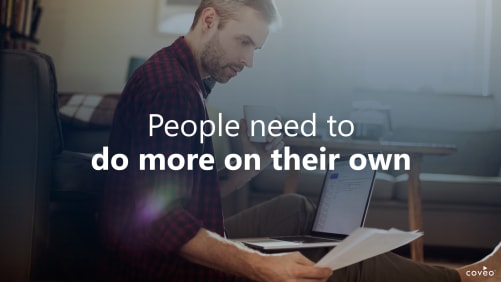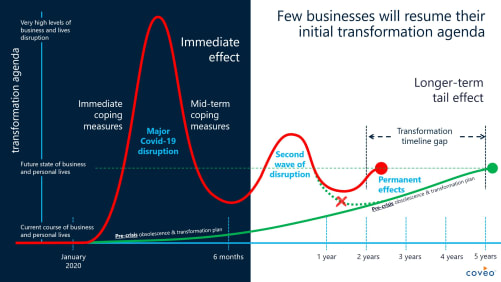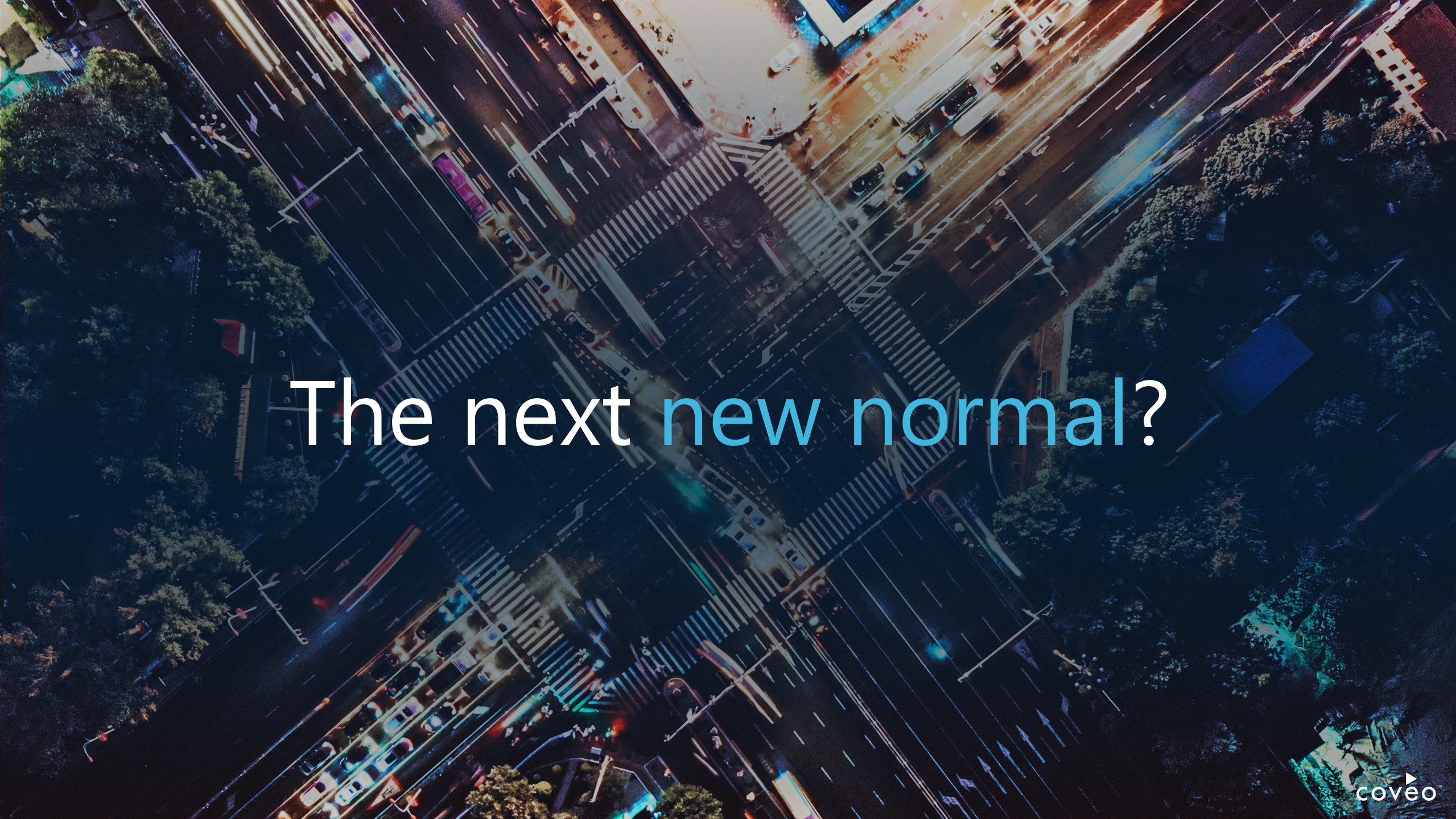Last Wednesday, Andy Hoar (CEO of Paradigm B2B & Co-founder at B2B Next) and Brian McGlynn (VP Commerce at Coveo) hosted the third live webinar in our ongoing Impact+ series: “The eCommerce Imperative: An Action Plan.” Andy is one of the world’s leading authorities on B2B eCommerce strategy – and his recommendations provided excellent insights for industry leaders struggling to understand how to adapt.
Whereas previous sessions focused on the broader state of our current digital reality, this served as a deep dive into the changing world of commerce to reveal how digital leaders are adapting their strategies to create the intelligent buying experiences needed to win now and in the future.
In commerce, self-sufficiency has become essential for both your workforce and for your customers. Employees can no longer simply turn to their co-worker for assistance or to ask a question, and customers are left without their friendly shop assistant to guide them by the hand on the path to purchase. This means the top priority and challenge for you has become helping people quickly get the exact information they need to continue to serve and shop online.

It is essential that you go digital quickly in order to cope with this immediate informational challenge and prepare to compete in the new normal that will follow.
“It’s a digital crunch, no question about it, it’s got to happen right away. But at the same time it’s a digital rush. It’s got to happen quickly. ” – Brian McGlynn #digitalcommerce pic.twitter.com/KVcpKCl7RP
— Coveo (@coveo) April 15, 2020
The fact of the matter is that people are becoming increasingly accustomed to a wholly digital life, and this will have permanent effects on customer behavior and expectations for the online experience you deliver. Brian himself mentioned that he doesn’t think he’ll return to flying 60% of the time for work, as digital has proven itself to be a viable alternative for in-person meetings. This shift comes with the expectation that digital will continue to prove itself as a stand-in for offline experiences and improve over time.
With this impending new normal on the horizon, the issue at hand is that there is a wide gap between the permanent behavior (and resultant expectations) it will bring into the present and the trajectory of existing technology to meet them anytime in the next five years.

Even if you already had a digital transformation plan in place, it must be accelerated. You simply can’t wait until tomorrow to meet the heightened experiential expectations that your customers have for your digital commerce channels today.
Brian then introduced the Coveo Experience Intelligence Platform (EIP) to show how it allows you to do this with ease, even if you have data in multiple formats across multiple silos. It stitches disparate data, product information, content and context, and then applies AI to tailor and optimize every interaction, ultimately enabling you to deliver intelligent shopping experiences that meet your customers’ accelerated expectations and your business objectives.
To learn more about this platform and how it can help you build the unique shopping experiences needed to succeed in the new digital reality, check out our Guide to Delivering Intelligent Shopping Experiences.
A conversation between Andy and Brian then followed, generating valuable insights into the changes under way, the new normal that is to come, and what can be done to make the most of it. It is best reflected in the following four lessons for the future:
1.) Question everything and start over.
“This is an opportunity to succeed. It’s also an opportunity to fail. And so smart companies are essentially reverting to the most fundamental question, which is: What business are we in?” – Andy Hoar
The first lesson that came out of their conversion is that you need to reevaluate your standard ways of doing things and determine whether they are actually working for your business and for your customers.
The disruption from this crisis has essentially unshackled you from your legacy business processes, existing business models, and even value proposition, giving rise to the possibility of “hitting the big reset button” and doing something you’ve always thought of doing or that your customers have always wanted you to do, but that you never had the chance or push to take on.
For B2B Manufacturers, this translates to getting to know your end users (or customers) and moving to sell direct. At a time when the channel has not only been disrupted, but quite frankly has been obliterated, you may have no choice but to do so, which provides a great opportunity to rethink the channel and develop a strategy to permanently sell direct in the future.
For B2B Distributors, this translates to tapping into trust and delivering better than ever. Presumably, you’ve built relationships and established a reputation for being able to deliver. At a time when people are desperately looking for certainty in their needs being met, you should leverage your ability to do so and focus on doing it better than you ever have before.
2.) Embrace AI.
“I’ve always said that the winner in this space is going to be the company or companies that create the best online offline experiences.” – Andy Hoar
The second lesson for the future is that you need to embrace artificial intelligence.
Buyers, especially B2B buyers, are looking to be very efficient. They don’t want to take time navigating around your website to find what they need. They know what they need and will search for it directly. So if they enter a 16-digit alphanumeric SKU code and get the first 15 right, the last one wrong, and end up with no results as a result when they search, they will be incredibly frustrated and might even leave.
AI has the capability to help understand how buyers search, and it uses probabilities to determine what it is they need or what recommendations they’re looking for, even if a query is incorrect. This means it has the potential to help you create a more efficient buying process, prevent buyer frustration, and boost customer retention.
3.) Focus on retention and loyalty.
“One metric today that I think is particularly important… is in the customer satisfaction realm. It’s retention. It’s retention and loyalty.” – Andy Hoar
Andy started this conversation off by saying that this is a time of opportunity and peril. The peril he was referring to is that of losing your customers. If you lose a customer right now, the cost of reacquisition would be 5-15 times higher than the current cost of retention.
Therefore, if you have found that your cost structure has changed, you should consider adjusting your prices, perhaps even lowering them unilaterally, to build more loyalty and retain your customers. Auto insurers have already done this as a result of less people driving and therefore less people getting into accidents.
The reality is that on the other side of this crisis, we could be in a different world. Customers may use this as an excuse, good or bad, to look at alternatives, and they may go elsewhere if their needs aren’t met. And the cost of trying to get them back may prove to be prohibitively expensive for you at that point.
4.) Assume all change will be permanent.
“I think customer behavior is going to fundamentally change in this period of time. The longer it goes on, the more permanent it’s going to be, the more dramatic it’s going to be.” – Andy Hoar
COVID-19 came along and disrupted everything. It’s not entirely clear what the long-term implications will be, but what is clear is that it has fundamentally changed how your customers behave and those changes will likely persist in some capacity.
The companies that respond to these changes now and also prepare for them to last will be the ones that will endure and emerge stronger on the other side. This requires getting closer to your customers and delivering the digital experience that they expect right now. Doing so may require challenging everything you know and resetting your organization to accelerate your digital transformation, but unprecedented times call for unprecedented measures. With the right technology, this is far easier to accomplish than you might think.
————
Watch the replay of The eCommerce Imperative: An Action Plan today! And dive into our next blog post to learn more about the role this session plays in the rise of Impact+.


